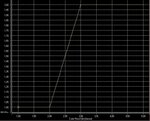akis
Junior Member level 1
First of all thanks for your help!
I did the same thing but tpd failed again!
Any idea?
Now for fanOut 2 to 5 i have to add the gates at the output of 3rd stage. Right?
And is it necessary to run every simulation(for fanout 1...5) 5 separate times?
Or i have to add code like this:
Vdd VDD VSS 'SUPPLY'
Vin A1 VSS=0 PULSE 0 'SUPPLY' 0ps 20ps 20ps 120ps 200ps
X1 A1 B1 VDD VSS INV_X1
X2 B1 C1 VDD VSS INV_X1
X3 C1 D1 VDD VSS INV_X1 m=fanout
X4 D1 E1 VDD VSS INV_X1
x5 E1 F1 VDD VSS INV_X1
.TRAN 1ps 200ps START=0ps sweep fanout 1 5 1
run this simulation but tpd was not rising every time(sometimes was falling).
here are the results:
tpdr= 1.1483E-11 targ= 1.8176E-10 trig= 1.7028E-10
tpdf= 7.4110E-12 targ= 3.5720E-11 trig= 2.8309E-11
tpd= 9.4470E-12
*** parameter fanout = 2.000E+00 ***
tpdr= 1.0593E-11 targ= 1.8298E-10 trig= 1.7239E-10
tpdf= 7.0239E-12 targ= 3.9184E-11 trig= 3.2160E-11
tpd= 8.8085E-12
*** parameter fanout = 3.000E+00 ***
tpdr= 1.0810E-11 targ= 1.8503E-10 trig= 1.7422E-10
tpdf= 6.6195E-12 targ= 4.3182E-11 trig= 3.6562E-11
tpd= 8.7147E-12
*** parameter fanout = 4.000E+00 ***
tpdr= 1.1117E-11 targ= 1.8717E-10 trig= 1.7606E-10
tpdf= 6.5845E-12 targ= 4.7403E-11 trig= 4.0819E-11
tpd= 8.8509E-12
*** parameter fanout = 5.000E+00 ***
tpdr= 1.1337E-11 targ= 1.8913E-10 trig= 1.7779E-10
tpdf= 6.1490E-12 targ= 5.1560E-11 trig= 4.5411E-11
tpd= 8.7428E-12
meas_variable = tpdr
mean = 11.0680p varian = 1.347e-25
sigma = 367.0738f avgdev = 293.1873f
max = 11.4830p min = 10.5931p
meas_variable = tpdf
mean = 6.7576p varian = 2.293e-25
sigma = 478.8820f avgdev = 367.9152f
max = 7.4110p min = 6.1490p
meas_variable = tpd
mean = 8.9128p varian = 9.205e-26
sigma = 303.3963f avgdev = 213.6820f
max = 9.4470p min = 8.7147p
Did you measure from rise=1 to rise=2 , and from fall=1 to fall=2 ?
This is a non-inverting gate, so you have to measure propagation delay times from first rise to second rise, resp. from first fall to second fall:
.measure tpdr
+ trig v(c1) val='supply/2' rise=1
+ targ v(d1) val='supply/2' rise=2
.measure tpdf
+ trig v(c1) val='supply/2' fall=1
+ targ v(d1) val='supply/2' fall=2
I did the same thing but tpd failed again!
Any idea?
Now for fanOut 2 to 5 i have to add the gates at the output of 3rd stage. Right?
And is it necessary to run every simulation(for fanout 1...5) 5 separate times?
Or i have to add code like this:
Vdd VDD VSS 'SUPPLY'
Vin A1 VSS=0 PULSE 0 'SUPPLY' 0ps 20ps 20ps 120ps 200ps
X1 A1 B1 VDD VSS INV_X1
X2 B1 C1 VDD VSS INV_X1
X3 C1 D1 VDD VSS INV_X1 m=fanout
X4 D1 E1 VDD VSS INV_X1
x5 E1 F1 VDD VSS INV_X1
.TRAN 1ps 200ps START=0ps sweep fanout 1 5 1
run this simulation but tpd was not rising every time(sometimes was falling).
here are the results:
tpdr= 1.1483E-11 targ= 1.8176E-10 trig= 1.7028E-10
tpdf= 7.4110E-12 targ= 3.5720E-11 trig= 2.8309E-11
tpd= 9.4470E-12
*** parameter fanout = 2.000E+00 ***
tpdr= 1.0593E-11 targ= 1.8298E-10 trig= 1.7239E-10
tpdf= 7.0239E-12 targ= 3.9184E-11 trig= 3.2160E-11
tpd= 8.8085E-12
*** parameter fanout = 3.000E+00 ***
tpdr= 1.0810E-11 targ= 1.8503E-10 trig= 1.7422E-10
tpdf= 6.6195E-12 targ= 4.3182E-11 trig= 3.6562E-11
tpd= 8.7147E-12
*** parameter fanout = 4.000E+00 ***
tpdr= 1.1117E-11 targ= 1.8717E-10 trig= 1.7606E-10
tpdf= 6.5845E-12 targ= 4.7403E-11 trig= 4.0819E-11
tpd= 8.8509E-12
*** parameter fanout = 5.000E+00 ***
tpdr= 1.1337E-11 targ= 1.8913E-10 trig= 1.7779E-10
tpdf= 6.1490E-12 targ= 5.1560E-11 trig= 4.5411E-11
tpd= 8.7428E-12
meas_variable = tpdr
mean = 11.0680p varian = 1.347e-25
sigma = 367.0738f avgdev = 293.1873f
max = 11.4830p min = 10.5931p
meas_variable = tpdf
mean = 6.7576p varian = 2.293e-25
sigma = 478.8820f avgdev = 367.9152f
max = 7.4110p min = 6.1490p
meas_variable = tpd
mean = 8.9128p varian = 9.205e-26
sigma = 303.3963f avgdev = 213.6820f
max = 9.4470p min = 8.7147p

